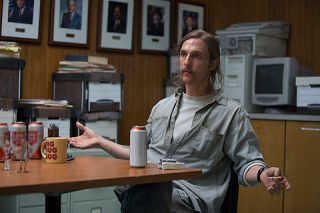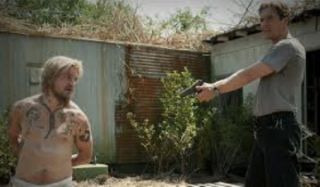Play
True Detective: A Psychological Analysis
True Detective: The identities and broken boundaries of Hart and Cohle
Posted February 17, 2014
Part two in the psychological analysis of “True Detective”. Read part I here and part III here
The Plot
Checking out leads, the two detectives eventually find the nomadic, revival-type preacher’s church that murder victim, Dora Lange, attended. Lange’s boyfriend and ex-con Reggie Ledoux, “a tall man with a shiny face" accompanied her.
Cohle, never one to sleep much, reviews files of deceased women and girls—suspecting this is more than a one off killing. Within this group, he finds a body with wounds and markings similar to Lange, and blood tests that are positive for meth and LSD, also like Lange. He believes the drugs could be the key and is thrust back into that dark, seedy world.

When the detectives move in to arrest Ledoux, without back-up, Hart discovers two children held captive, and true to being a ‘family man’, he snaps and shoots Ledoux in the head. However, their official statement was that there was an ambush and they returned fire in self-defense. They lied after it happened, and they lied in the present interrogation. Cohle will not betray Hart's actions; their partnership is solidified and still stands throughout the years—or does it?
Hart
When Hart’s mistress tells him he wants to have his cake and eat it too, he replies, "What good is cake if you can't eat it?" He initially appears to juggle family, job and other women just fine, but this is all a façade.
Hart, the Louisiana good ole boy cop and churchgoing Christian is constantly talking about family being important to a man. He says about Cohle, "Past a certain age, a man without a family can be a bad thing." Hypocritical at best.
Yet, Hart is staying away from home more, blaming “the job” and it's starting to reflect in his daughters' behavior. Last week was the positioning of the dolls to look like a gang bang. This week the older daughter gets in trouble at school for drawing several pictures—naked men with large penises and women engaging in sex acts.
For all the talk of keeping work and home separate, it’s clear that kids know so much more than we think—or would wish. The sexual attacks, the prostitution, the mistress—have all infiltrated his home. As the daughters age the older teenager is caught in a consensual sexual act with two older boys in a car leading Hart to call her a slut- projection clearly at play.
The sexual drawings, doll play and now acting out by a teenage girl are all suggestive of sexual abuse, but by whom? Possibly Hart, but he seems too shocked for this. Maybe the governor's cousin, a preacher in his own right? Or perhaps, most likely his father in law, Maggie’s father, a rich old Louisiana man living in a plantation style house, though he has only been seen once.
His wife knows, and is concerned. She calls him out, demanding to know what's wrong. Yes, he's afraid of getting older, but Hart uses the serial killer case to scare his mistress in order to control her, the first indicator of his possessiveness, which is quickly re-enforced.
When Hart sees his mistress at a dance with another man, he follows her home and violently assaults the guy demanding an answer to, “Did she suck your dick!!?"
When he comes home and discovers Cohle has mowed his lawn and is sitting in the kitchen talking to his wife he furiously forbids another man from "mowing my lawn!" and tells Cohle he'd better never do it again, like that's the thing that is wrecking his marriage. Clearly he feels threatened since he is away from home having an affair, that another man will step in and take his place. Clearly, home is not where the Hart is.
Of course, it's just a matter of time before secrets are no longer secrets. The girlfriend, angry because of her married lover's jealous outburst, visits the wife and tells all. Hart is kicked out. He has lost the family he claimed to love so much and is forced to move in with Cohle.
Time heals wounds, as they say, and the same can be said about Hart's infidelity. Through hard work, rehab and promises, Hart works to win his family back.
Cohle
Despite the dark side seen in Cohle, his past is haunting and he uses insomnia to spend hours looking at crime scene photos. We then see Cohle on a blind date. He smiles and dances, giving her a couple of whirls, but it’s forced. It was a fleeting glimpse of “normal’ before the demons, troubled past and disturbing present reemerge.
All the evidence focuses on Reggie Ledoux, a meth cooker for a Texas motorcycle gang that Cohle had dealt with in his prior undercover capacity. Cohle tells the interviewing detectives he took leave to go to Alaska and care for his dying father. But this was merely an excuse for going off the grid and back into an unsanctioned, undercover role.
We initially feel that Cohle’s demons are a result of his daughter's death, but now it’s clear he embraces the undercover lifestyle. He's back in his element. Stealing cocaine from the evidence room, he re-establishes his persona as former drug dealer, "Crash".
It’s telling how quickly Cohle embraces his former life, heavy drinking and snorting coke and crystal. The drugs, the danger—he loves it all and is at top of his game. True, he wants to get his man but, he loves the life and this is all just a reason to re-embrace it.
In a shootout reminiscent of the wild west, Cohle ventures back to the dark side and emerges with Ginger, the gang leader with the info on Reggie Ledoux. Hart pulls the car up just in time for Cohle to shove Ginger into the back seat and escape, with a helicopter flying above, police units blocking off the neighborhood and the sounds of gunfire still sounding in the distance.

Since the Lange case is now solved, the two detectives' lives settle into a quiet time, which Hart describes as “the good years”. Hart has returned to his family, and Cohle is in a committed relationship with a doctor. But we sense this is just the calm before the storm.
Hints are given that there is more to come. Hart’s daughter's promiscuity, Reggie Ledoux's spiral brand on his back, references to rich powerful men involved with children. Then, in 2002, during the interrogation of a double homicide suspect, Cohle receives credible evidence that the ‘Yellow King’ still lives and that the killer(s) is out there, plotting, planning…and killing.
Before Cohle can follow up with the suspect, he kills himself in jail after receiving a phone call from (who?) a pay phone. There are hints that a cover up is in place, from vastly wealthy and powerful men that could reach as high as the governor’s office itself.
As Cohle says, "Life is like a dream and, like a dream, sometimes there's a monster at the end"
For more, check out Is Hart The Yellow King?
AND--- read part I here and part III here




